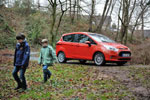 Ensure it is Ready for Family Life
Ensure it is Ready for Family Life
· Ford “child-proofs” the new B-MAX; subjects compact multi-activity vehicle to fabric and plastic testing, including mud, milk and fizzy drink tests, to simulate punishment from children and pets
· Engineers soak interior materials to gauge stain resistance; conduct testing with a sharp-spiked “mace”; and use Velcro to replicate fabrics snagging on children’s bags and clothing
· Ford tests impact resistance of plastics using a rubber ball ten times heavier than a regulation football
Every parent is familiar with the challenge of keeping a new car clean in the face of everyday use by children and pets. Ford has now tried to make that job a little easier for mums and dads by “child-proofing” the new B-MAX.
Engineers subjected the new B-MAX to laboratory tests that simulate the toughest treatment children and pets can dish out, including soaking materials in milk and fizzy drinks; testing fabrics with a “mace”; and pounding plastics with a heavy rubber ball.
“By testing for everything from soft drink spills to muddy boots, we’ve made sure the B-MAX interior is ready for anything.” said Mark Montgomery, senior materials engineer, Ford of Europe. “I’ve got young children myself, so I’m very familiar with the mess they can create.”
The B-MAX’s Ford Easy Access Door System provides unrivalled access for families and luggage through hinged front doors and sliding rear doors that integrate the central body pillars. Samples of all leathers and fabrics used in the compact multi-activity vehicle’s interior were tested for stain resistance and ease of cleaning after being soaked for 24 hours in the liquids – and being smeared with soil and grease.
Engineers also tested resistance to damage that can be caused by abrasive zips and fasteners found on children’s clothing and bags. The “mace test” used a metal ball with needle-sharp spikes to brush fabrics 600 times and replicate the effect of snagging zips and studs; also engineers carried out a special test to repeatedly rub the seat material with Velcro.
Impact tests – conducted at temperatures as low as -30 C when plastic is more brittle – used a rubber ball ten times heavier than a regulation football to ensure that plastic parts could withstand bumps and knocks. Fabrics were also rubbed 60,000 times in a 17-hour non-stop wear test; metal spikes were scraped across plastic parts to test scratch resistance; and carpets were checked for durability on a special test rig fitted with rough abrasion wheels.
“These tests make sure we’ve done everything possible to make sure the car looks as good the thousandth time that families sit in it as it does the first time,” added Montgomery.




